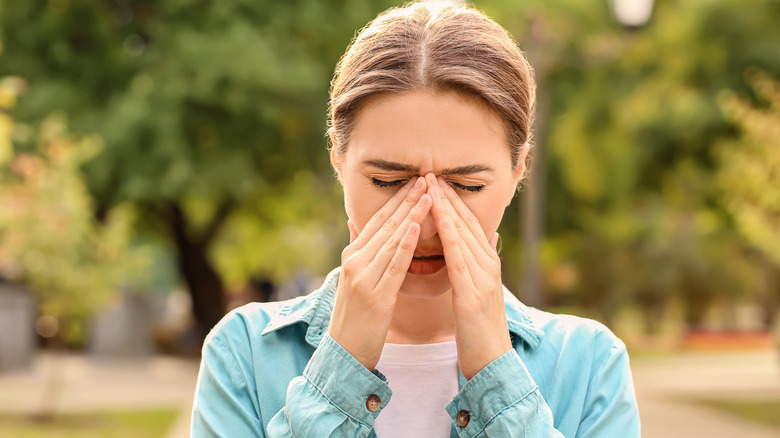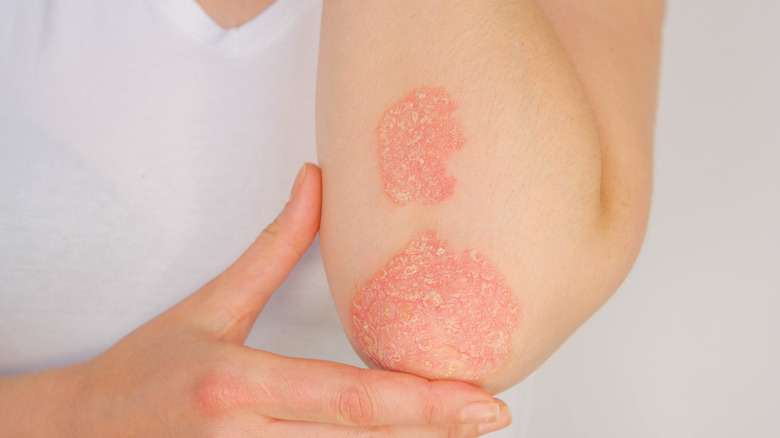Zyrtec Explained: Usage, Dosage, And Side Effects
Zyrtec, or cetirizine, is a second-generation antihistamine. According to Cetirizine, it was initially approved by the FDA in 1995 as a prescription drug, but it later was approved to be sold over-the-counter (OTC) without a prescription. As Healthline explains, cetirizine is inexpensive and available from a variety of companies. Apart from Zyrtec, some of the other brands include Aller-Tec and Alleroff. There are also many generic versions of Zyrtec that contain cetirizine, which are even less expensive than the brand names. You can always check the list of active ingredients on the back of any medication you're considering buying to confirm whether or not it contains cetirizine.
Although Zyrtec is available over-the-counter, Healthline recommends talking to your doctor before you try it. In some cases, your doctor may recommend a different antihistamine for your particular condition. You can also talk to the pharmacist at your local drug store if you have any questions or concerns before buying this medication.
Zyrtec may be the most popular OTC antihistamine in the U.S.
According to Statista, about 50% of Americans who have allergies use antihistamine pills like Zyrtec, Benadryl, or Allegra, all of which are available over-the-counter. Of those antihistamines, Zyrtec may be the most popular, followed by Flonase (a nasal spray), Claritin, Allegra, and Benadryl (via Statista).
Like Zyrtec, Claritin (loratadine) and Allegra (fexofenadine) are both second-generation antihistamines. The Cleveland Clinic explains that second-generation antihistamines were developed after first-generation antihistamines, as the name implies. First-generation antihistamines became available in the 1930s, while second-generation antihistamines were approved in the 1980s. The primary difference between these two types of antihistamines is that second-generation antihistamines don't cause as much drowsiness and interact with fewer drugs than first-generation antihistamines, and as such, they are considered the safer option between the two. By contrast, Benadryl (diphenhydramine) is a first-generation antihistamine, and it is well-known for its ability to induce drowsiness.
This is part of the reason why Zyrtec is such a popular choice to treat allergies: It's much less likely to cause drowsiness than Benadryl or other first-generation antihistamines. What's more, a review from Allergy and Asthma Proceedings says cetirizine (Zyrtec) works faster than the other common second-generation antihistamines, making it a more popular choice than Claritin or Allegra.
Zyrtec is used to treat seasonal allergies or hay fever
The primary use of Zyrtec is to treat allergies. The Cleveland Clinic says it can be used to treat seasonal allergies, also known as hay fever. Another term that's used to describe seasonal allergies is allergic rhinitis. As the American College of Allergy, Asthma, and Immunology (ACAAI) explains, seasonal allergies are a form of allergic rhinitis. Approximately 40-60 million Americans may deal with allergic rhinitis every year.
A review from Pharmacology compared the effects of some of the common second-generation antihistamines on allergic rhinitis and found cetirizine (Zyrtec) to be the most promising treatment option. The authors comment that it was at least as effective, if not more so, at treating nasal and eye symptoms of allergic rhinitis and improving quality of life than other second-generation antihistamines. Moreover, it's considered to have a better pharmacological profile than other second-generation antihistamines and is well-tolerated. This makes Zyrtec a popular choice for treating seasonal allergies or hay fever, which the ACAAI says is most common during the "spring, summer, and early fall" seasons.
Year-round allergies can be treated with Zyrtec
In addition to treating seasonal allergies, Zyrtec can also be used to treat year-round allergies, or allergic reactions that aren't related to hay fever. Healthline explains that coming into contact with any substance to which you are allergic (i.e. an allergen) causes your body to produce histamine, which then triggers the symptoms of an allergic reaction. Antihistamines like Zyrtec counter these symptoms. That said, Zyrtec can't prevent allergies.
A review from Allergy and Asthma Proceedings analyzed the effects of diphenhydramine (a.k.a. Benadryl, a first-generation antihistamine) compared to those of some common second-generation antihistamines for the treatment of acute allergic reactions. This review found cetirizine (Zyrtec) to be more effective for the treatment of acute allergies than other second-generation antihistamines, including loratadine (Claritin). They also note that it worked more quickly than any of the other second-generation antihistamines. While diphenhydramine also works quickly, the authors caution that it has strong sedating effect, making cetirizine the most effective and safest option of all these antihistamines.
Zyrtec can treat urticaria (skin hives)
Zyrtec can be used to treat urticaria, or skin hives. The ACAAI says that at some time or another, about one in five people will experience the itchy and uncomfortable condition. There are many potential causes: Certain foods, drugs, insect bites, latex, pet dander, pollen, plants, viral or bacterial infections, blood transfusions, and even physical stimuli (such as pressure, extreme temperatures, sun exposure, or exercise) all have the potential to trigger skin hives.
A review published in the Cochrane Database of Systematic Reviews analyzed the effects of various antihistamines for treating urticaria. As the authors explain, the condition often has "no identifiable external cause," meaning it isn't always possible to figure out what triggered the reaction. Regardless of the trigger, cetirizine (Zyrtec) was shown to be very effective for treating urticaria. When taken once daily for several weeks, or in some cases up to three months, cetirizine was able to heal the urticaria completely. The authors note, though, that other second-generation antihistamines like loratadine (Claritin) had similar effects when treating skin hives.
Zyrtec can treat pityriasis rosea (skin rash)
If you have pityriasis rosea, a type of skin rash, your doctor may recommend you take Zyrtec. The Mayo Clinic says this typically starts as an oval-shaped rash on the face, chest, stomach, or back area. After a few days or weeks, it can spread to other parts of the body in the form of small, itchy bumps. According to Johns Hopkins Medicine, the cause of pityriasis rosea isn't known, but the consensus is that it's most likely caused by a bacterial or viral infection. In some cases, a cold may precede the rash.
While treatment isn't strictly necessary, as the rash will eventually go away on its own, some people may want treatment depending on the severity or other concerns. A review from the Cochrane Database of Systematic Reviews analyzed randomized controlled trials that tested various treatments of pityriasis rosea, and this review found cetirizine (Zyrtec) to be part of an effective treatment for the condition. The authors note that standard care for pityriasis rosea includes a combination of cetirizine and calamine lotion, but treatment was found to be even more effective when the antiviral drug acyclovir was added to the plan. Additionally, the authors note that cetirizine is often used to treat itchy skin, regardless of what caused it.
Zyrtec can be combined with a stimulant to treat allergies and ADHD in children
Zyrtec has also been found to be effective for treating children who have both ADHD and allergies, when combined with a stimulant. A randomized controlled trial from the Journal of Allergy and Clinical Immunology tested three different treatments for children with ADHD and allergies: cetirizine (Zyrtec), methylphenidate (a stimulant also known as Ritalin), and a combination of both cetirizine and methylphenidate. The authors found that seasonal allergies improved the most in the group that took both drugs, as did the behavioral issues associated with ADHD.
The authors of this review point out that ADHD and allergies have some symptoms in common: difficulty focusing and learning. In fact, they claim that allergies can actually contribute to the development of ADHD in a small minority of children. With this in mind, it's very important to treat allergies in childhood, in part to help prevent them from causing other health issues, and Zyrtec has been shown to be effective for this purpose. When using Zyrtec (or generic cetirizine) to treat a child's allergies, make sure to buy a product specifically designed for children, as the dosage will be slightly different. WebMD says children's Zyrtec comes in chewable tablets, fast-dissolve tablets, and flavored syrup.
Typical dosage of Zyrtec is 5 or 10 mg once per day
Your doctor will most likely either recommend taking 5 or 10 mg of Zyrtec, depending on your age and the severity of your allergies or condition. Healthline says the standard dosage is one 10-mg pill once per day, but for more mild allergies, your doctor may recommend you take just 5-mg at a time. For children younger than 6 or adults older than 65, a different dose may be necessary. According to DailyMed, the standard dose for children between 2 and 6 years old is 2.5 mg, and for adults over 65, the standard dose is 5 mg. These doses are actually given in milliliters (mL), because the dosage recommendation is for the syrup version of children's Zyrtec, but in this case, 5 mL of this medication also contains 5 mg of cetirizine. Of course, this information is just a general guideline, and you should always consult with your doctor to determine the best dose for you or your child before trying this medication.
Zyrtec-D is a combination of Zyrtec and a nasal decongestant
If you're dealing with a combination of allergies and severe congestion, you have another option: Zyrtec-D. As WebMD explains, Zyrtec-D contains both cetirizine as well as pseudoephedrine, a nasal decongestant. The combination of the antihistamine and decongestant work together to provide relief for severe allergic rhinitis, but Zyrtec-D most likely isn't necessary for mild to moderate cases.
Like other nasal decongestants, pseudoephedrine relieves the swollen blood vessels in the nasal cavities by making them more narrow, which has the effect of opening the airways and reducing congestion. Because Zyrtec-D contains a high dose of pseudoephedrine, it's not recommended for children under 12 years old. By contrast, regular Zyrtec or generic cetirizine is safe for children (via WebMD), but make sure to buy the version formulated for children if using the medication to treat a child's allergies. The Mayo Clinic says small amounts of pseudoephedrine may be safe for children, but the amount found in Zyrtec-D is meant for adults.
Most common side effects of Zyrtec
Like other second-generation antihistamines, Zyrtec doesn't cause as much drowsiness as first-generation antihistamines. As Cetirizine explains, second-generation antihistamines like cetirizine (Zyrtec) don't cross the blood-brain barrier as much as first-generation antihistamines, which means they have fewer adverse side effects such as severe drowsiness. That said, Healthline explains that Zyrtec can still cause some drowsiness. The most common side effect of this medication is "excessive tiredness," but most people who take Zyrtec won't experience this. The National Health Service (NHS) says a little more than 10% of people who take cetirizine will have this side effect.
According to Healthline, other side effects of Zyrtec include dry mouth, stomach pain, diarrhea, and vomiting, but the NHS says these are even less common, occurring in only around 1% of people. They recommend speaking with a doctor or pharmacist if you experience any of these side effects when taking Zyrtec. In general, the medication is very well-tolerated, and most people who take it won't experience any side effects at all.
Zyrtec shouldn't be taken with alcohol or other depressants
As with all medications, Zyrtec has the potential to interact with other drugs or substances, so you'll want to verify that it doesn't interact with anything you're currently using before taking it. According to Cetirizine, Zyrtec shouldn't be taken alongside alcohol or any other central nervous system depressants. The National Institute on Drug Abuse says these include hypnotics, sedatives, and tranquilizers. Valium, Klonopin, Xanax, Ambien, and Lunesta are some of the commonly prescribed drugs that fall into this category, so you'll want to avoid Zyrtec if you're taking any of these medications.
Cetirizine also cautions that nursing mothers shouldn't use cetirizine. Pregnant women may be able to take it when necessary, but first-generation antihistamines are more likely to be recommended during pregnancy.
Talk to your doctor if you're interested in taking Zyrtec, and be sure to disclose any other medications or supplements that are part of your daily routine so they can advise you about possible interactions. As with all medications, it's best to use Zyrtec under the supervision of a doctor or healthcare professional.










